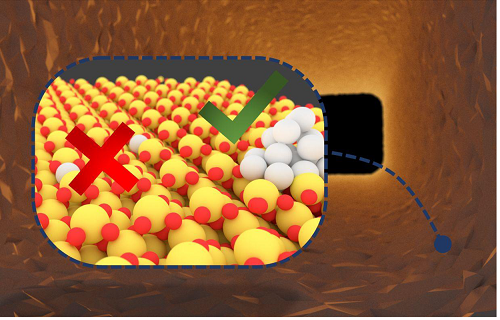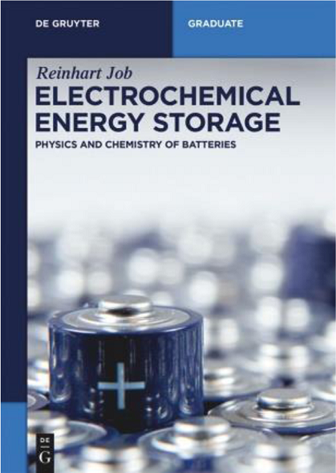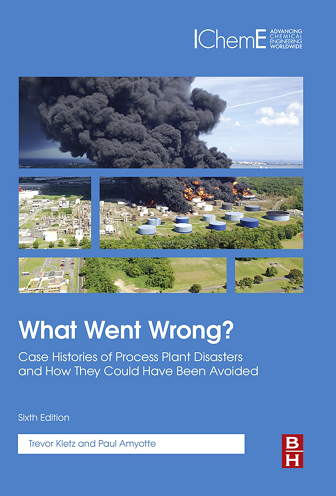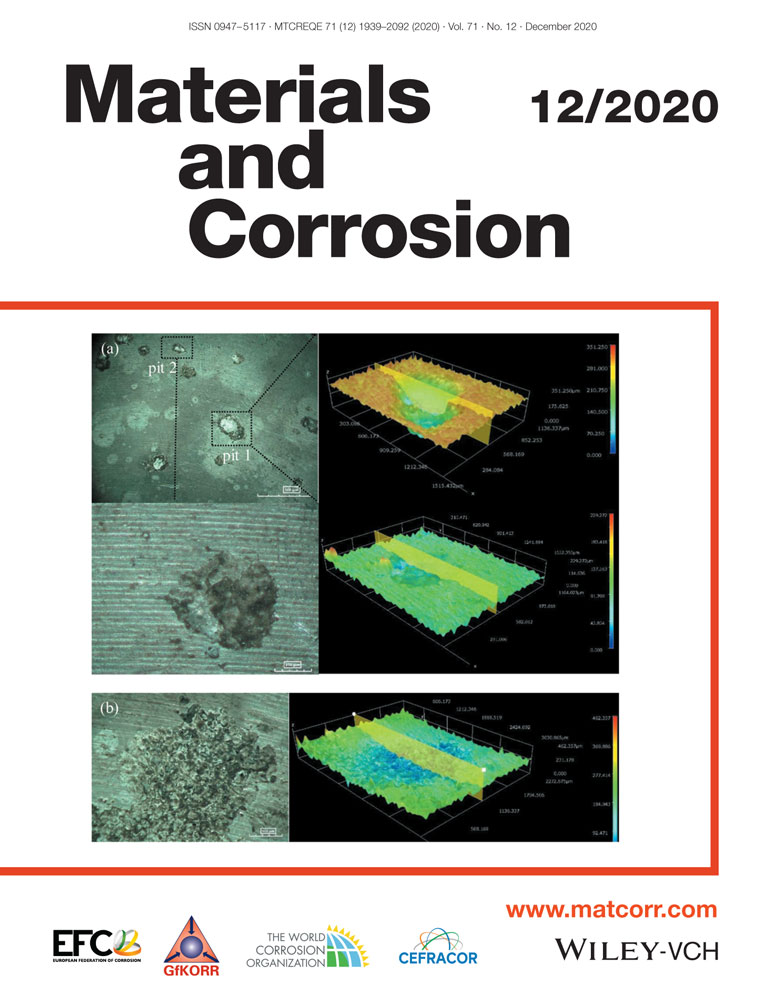Corrosion news
 The German News Section ,,Korrosionsnachrichten“ is available free of charge on the homepage of Materials and Corrosion: www.matcorr.com
The German News Section ,,Korrosionsnachrichten“ is available free of charge on the homepage of Materials and Corrosion: www.matcorr.com
Community News
Noble Metal Clusters Can Enhance Performance of Catalysts and Save Resources
Fig.: Schematic representation of a noble metal catalyst with inactive single atoms (left) and active clusters (right; noble metal: white; carrier metal: yellow; oxygen: red). (Graphics: Florian Maurer, KIT)
Noble metal catalysts are used for a wide range of reactions. Among others, they are applied in nearly all combustion processes to reduce pollutant emissions. Often, they consist of very small particles of the active component, such as a noble metal, which are applied to a carrier material. These so-called nanoparticles are composed of several thousands of metal atoms. “But only atoms on the outside are active in the reaction, while most atoms remain unused,” explains Professor Jan-Dierk Grunwaldt from KIT's Institute for Chemical Technology and Polymer Chemistry (ITCP). By changing operation conditions, the structure of such a catalyst and, hence, its activity may be changed. “At high temperatures in the exhaust gas system of a car, which are reached during a longer drive on a motorway, for instance, interaction between the noble metal and carrier may lead to the formation of single atoms, i.e. isolated, separate metal atoms on the carrier,” Grunwaldt says. “Such single-atom catalysts might be expected to reach a very high utilization rate of the noble metal components, because all atoms can theoretically participate in the reaction.” Contrary to this expectation, however, the team of Grunwaldt, in cooperation with professors Christof Wöll from the Institute of Functional Interfaces of KIT and Felix Studt from KIT's Institute of Catalysis Research and Technology, has found that these atoms first have to form noble metal clusters under reaction conditions to become active.
The researchers specifically induced the formation of single atoms and examined their structure thoroughly during the reaction. With the help of highly specialized spectroscopy and theoretical calculations, which were used for the first time ever for this class of catalysts, the team succeeded in explaining why platinum atoms frequently have a low activity. “To convert pollutants, they usually have to react with oxygen in the catalyst. For this, both components must be available at the same time and place, which cannot be achieved for isolated platinum atoms, as the oxygen for the required reaction is much too strongly bound to the carrier component – in our case cerium oxide,” says Florian Maurer from ITCP, one of the main authors of the study. “After breaking the platinum-cerium oxide bonds, platinum atoms can move across the carrier surface. In a next step, these platinum atoms form small platinum clusters, on which the reaction takes place much faster than on single atoms.”
Clusters Have an Optimal Structure for High Activity
The team's studies prove that neither nanoparticles nor isolated atoms reach the highest activity. “The optimum lies in between. It is reached by small noble metal clusters,” Grunwaldt says. “Stabilizing these noble metal clusters might be the key to substantially reduce the consumption of noble metals when producing catalysts. For years, increasingly fine distribution of the noble metal component has been one of the main strategies in designing new catalysts. Our experiments have now revealed the limits in the atomic ran-ge.” The results of the study will now be used for knowledge-based design and development of catalysts of enhan-ced stability and long-term activity. This will be a major focus of the work of the Karlsruhe Exhaust Gas Center of KIT, whose Scientific Director, Dr. Maria Casapu, is co-author of the study.
For further information, please contact: Karlsruher Institut für Technologie (KIT), Monika Landgraf, Head of Corporate Communications, Chief Press Officer Kaiserstraße 12, 76131 Karlsruhe, Tel.: + 49 721 608-41150, Fax: -43658, [email protected], www.kit.edu –CNE1520
Books
Electrochemical Energy Storage - Physics and Chemistry of Batteries, Reinhart Job, Walter de Gruyter GmbH, Berlin/Boston, 2020, 248 pages, 78 figures, 10 tables, 70 €, ISBN: ISBN 978-3-11-048437-3 (eBook: 978-3-11-048442-7)
Currently, storage of electric energy is becoming more and more interesting in terms of applicability and efficiency. One way is the electrochemical storage by already well-developed battery-systems. This textbook provides an introduction into physical and chemical processes necessary for battery application.
After introducing into the topic, thermodynamic basics, from thermodynamic laws to chemical potential, are presented.
The third chapter is dedicated to the basics of electrochemistry. Starting with solution properties of the electrolyte, electrochemical electrodes and electrochemical cells are covered, followed by related thermodynamics (Nernst equation and standard electrode potential) and a part on energy storage by electrochemical reactions.
Chapter 4, as the largest of the book, deals with batteries. First, relevant parameters, like charging/discharging behavior and capacity are discussed, followed by historically important batteries. All battery-types, currently in use, are described afterwards regarding their mechanisms. This chapter closes by technically important secondary batteries, commonly called accumulators.
Since nowadays environmental aspects are very important, the fifth chapter is on raw materials for lithium-ion batteries. Extraction and exploitation processes are described in detail for lithium, cobalt, nickel, manganese and graphite.
Some pages provide a collection of references for further reading about the topic covered by this textbook, arranged according the single chapters.
This book fulfills its intension to serve graduate students of electrical engineering as an introduction into the field of batteries. Even students and interested readers of other faculties might find an introduction in physical and chemical background of batteries. –CBE1720
What Went Wrong? Case Histories of Process Plant Disasters and How They Could Have Been Avoided, Trevor Kletz, Paul Amyotte, 840 pages, 207 figures, 13 tables, 2019, 6th edition, Butterworth-Heinemann Inc, Woburn, 109,95 €, 978-0-12-810539-9 (ebook: 978-0-12-810540-5)
Plant and process safety are very important within the daily business not only in industry. Within its 6th edition complete analysis of design, operational, and management causes of process plant accidents and disasters are collected by Paul Amyotte basing on Trevor Kletz's legacy. Examples shall help readers in understanding what went wrong, why it went wrong and how to avoid similar tragedies without having to experience the loss incurred by others and themselves. Each main part ends with an opportunity for reflection to recall the lessons learned from the examples shown.
Authors introduce to the topic by case histories and their use in enhancing process safety knowledge and the most devastating disaster our days (Bhopal).
The next part is dedicated to maintenance and operations. Examples of accidents caused by preparation, performance and operating methods are presented as well as such occurred when entering vessels or other confined spaces and some said to be due to human error or unclear labeling. It ends with some thoughts on testing of trips and other protective systems.
What kind of effects equipment and construction materials can cause is discussed within the next 5 chapters, divided in storage tanks, stacks, pipes and vessels, tank trucks and tank cars, other equipment and materials of construction.
Hazards and loss of containment is the heading for the following chapters on leaks, liquefied flammable gases, hazards of common materials, static electricity, planned and unplanned reactions as well as explosions.
Beside actual accidents a very important aspect is the right communication of knowledge gathered during accidents in other industries. How design and modifications can cause or prevent accidents one can find in chapters 30 to 36.
Within the concluding part such thoughts, like ,,an accident that may have affected the future of process safety“ and ,,an accident that did not occur“, are shared with the reader, supported by considerations on relative frequencies of incidents, why one should publish accident reports and some tips for accident investigators.
This collection of, unfortunately, spectacular failure cases fulfills its intension of being the ultimate resource of experienced-based analysis and guidance for safety and loss prevention professionals. Everyone who is dealing with process and/or plant safety shall have taken at least a look into this book. –CBE1820
Ralph Bäβler
Conferences
29th Topical Meeting of the International Society of ElectrochemistryEnergy and water: electrochem-istry in securing the sustainable society development
April 18 – 21, 2021, Mikulov (Czech Republic)
As the main conference motto indicates, energy and the environment probably represent the two most important challenges currently facing mankind. At the same time, although they may sound heterogeneous and wide-ranging, these topics are closely interconnected by numerous aspects and they form a unique research and development field. Electrochemistry can make a significant contribution to this important complex topic in a number of unique ways. The main obstacle to the broad application of electrochemical techniques for water treatment technology is the accessibility of an affordable and, preferentially, environmentally neutral source of electrical energy. On other hand, this is closely connected with the availability of energy conversion and storage technology, enabling efficient exploitation of renewable energy sources which are characterised by intermittent supply. In certain cases, pollution treatment can be directly connected with electrical energy production, e.g. in biological fuel cells or in the reverse electrodialysis process using concentrate streams from reverse electroosmosis, among other processes. Electrochemistry also provides unique opportunities for monitoring both the pollution level and the operation of the technologies involved, as well as the development of new, related, and ideally pollution-free technologies. The combination of basic electrochemical research, electrochemical process engineering and environmental protection with renewable energy offers new and efficient approaches to a more sustainable development for the benefit of society.
For more information, please contact: International Society of Electrochemistry, [email protected], www.topical29.ise-online.org –CCE3320
Advances in Corrosion Protection by Organic Coatings
September 5 – 9, 2021, Cambridge (United Kingdom)
-
Sustainable coatings and formula-tions
-
Pigments, inhibitors and smart coatings
-
Smart and functional coatings
-
Mechanisms of protection
-
Film formulation and degradation
-
Adhesion and its enhancement
-
Under-film corrosion
-
Surface preparation
-
Text methods
-
Other related areas.
For more information, please contact: Stuart Lyon, AkzoNobel Professor of Corrosion Control, University of Manchester, [email protected], www.acpocconference.org –CCE3420
European NDT&CM2021
October 4 – 8, 2021, Prague (Czech Republic)
The 2nd European NDT & CM Days in Prague will consist of – 11th workshop NDT in Progress, International conference NDE & CM for Safety, 51st annual CNDT conference Defektoskopie 2021 and NDT & CM Expo. During these days you can visit four different events at the Cubex centre Prague. It will be an exceptional opportunity to meet people interested in research & development, as well as in practice, standardization and the application of all NDT/NDE, CM and SHM methods with an emphasis on areas of modern Industry.
These “Days” will be one of the most important NDT, CM, SHM and related branches European events in 2021. We hope that the 2nd European NDT&CM Days 2021 will not only be an opportune time for exchanging research findings but also an occasion for strengthening existing contacts and establishing new ones for all participants. Naturally, seminars, workshops, excursions and other social events will be organized.
Topics
-
NDT Progress
-
NDT & CM for Safety
-
Defektoskopie
This event will be organized as an 51st international annual meeting of the Czech society for NDT. All technical papers at the conference will be presented in Czech or Slovak (potentially in English and Russian) languages.
For more information, please contact: GUARANT International spol. s r.o., Českomoravská 19, 19000 Prague 9, Czech Republic, Tel.: + 420 284 001 444, [email protected], www.endtcm21.com –CCE3520
Calendar of Events
 New Entry
New Entry
 Conference/Workshop/Symposium
Conference/Workshop/Symposium
 Fair
Fair
 Course
Course
| January 2021 | ||
10. – 14.1. Milan (Italy)
|
6th International Conference on Steels in Cars and Trucks, SCT 2021 |
TEMA Technologie Marketing AG Aachen Germany |
| February 2021 | ||
3. – 5.2. Sugar Land, TX (USA)
|
International Chemical and Petroleum Industry Inspection Technology Conference 2021 (ICPIIT 2021) |
American Society for Nondestructive Testing International Service Center Columbus USA |
16. – 17.2. Tokyo (Japan)
|
Stainless Steel World Japan |
Ms Kiyo Ichikawa Conference Organizer |
24. – 25.2. Rotterdam (Netherlands)
|
Duplex World Seminar & Summit 2021 |
Stainless Steel World/KCI GmbH Kleve Germany |
24. – 25.2. Rotterdam (Netherlands)
|
Heat Exchanger World |
John Butterfield |
| March 2021 | ||
1. – 3.3. Darmstadt (Germany)
|
InCeight Casting |
Fraunhofer-Institut für Betriebsfestigkeit und Systemzuverlässigkeit LBF Darmstadt |
9. – 10.3. Coventry (United Kingdom)
|
Workshop on structural integrity, NDT and CM requirements for Industry 4.0 |
Conferences and Events Department The British Institute of Non-Destructive Testing Northampton UK |
12. – 15.3. Vienna (Austria)
|
International Congress on Advanced Materials Sciences and Engineering |
Ms. Eve Yuan International Science and Technology Conference Institute |
23. – 27.3. Bologna (Italy)
|
12th Aluminium Two Thousand World Congress together with the 7th ICEB (International Conference on Extrusion and Benchmark) |
Interall Srl Modena Italy |
22. – 26.3. Bremen (Germany)
|
8th European Coke an Ironmaking Congress (ECIC) and 9th International Conference on Science and Technology of Ironmaking (ICSTI) |
TEMA Technologie Marketing AG Carsten Scheele Aachen Germany |
| April 2021 | ||
18. – 21.4. Mikulov (Czech Republic)
|
Energy and water: electrochemistry in securing the sustainable society development |
International Society of Electrochemistry |
18. – 22.4. Salt Lake City, UT (USA)
|
CORROSION 2021 |
NACE International Houston, Texas USA |
21. – 22.4. Bristol (United Kingdom)
|
Aerospace Event 2021 |
Conferences and Events Department The British Institute of Non-Destructive Testing Northampton UK |
27. – 30.4. Berlin (Germany)
|
InnoTrans 2021 |
Messe Berlin GmbH Germany |
28. – 29.4. Aachen (Germany)
|
Advanced Battery Power Conference 2021 |
Haus der Technik e.V. Essen Germany |
| May 2021 | ||
5. – 6.5. Brno (Czech Republic)
|
Stainless 2021 |
Verlag Focus Rostfrei GmbH Xanten Germany |
10. – 12.5. Florence (Italy)
|
Third International Workshop: Analysing Art: New Technologies – New Applications |
Workshop Chair Professor Roman Gr Maev, |
17. – 21.5. San Diego, CA (USA)
|
SMST 2021 Shape Memory and Superelastic Technologies |
ASM World Headquarters Materials Park, OH USA |
19. – 21.5. Osaka (Japan)
|
9th Annual World Congress of Advanced Materials (WCAM-2021) |
Ms. Elsa Wang Program Coordinator of WCAM-2021 |
24. – 27.5. Quebec (Canada)
|
ITSC 2021 International thermal spray conference and exposition “Versatile Surface Engineering for Environmental Solutions” |
ASM World Headquarters Materials Park, OH USA |
27. – 29.5. Istanbul (Turkey)
|
Corrosion and Surface Protection for Steel CASP 2021 |
Turkish Constructional Steelwork Association Istanbul Turkey |
31.5. – 4.6. Incheon (Korea)
|
!POSTPONED! 20th World Conference on Non-Destructive Testing (WCNDT 2020) |
The Korean Society for Nondestructive Testing Seoul Korea |
| June 2021 | ||
8. – 10.6. Antibes Juan-les-Pins (France)
|
7th Days Cathodic Protection & Associated Coatings EFC Event No. 455 |
CEFRACOR Centre Français de l'Anticorrosion Paris France |
14. – 18.6. Frankfurt (Germany)
|
ACHEMA 2021 |
DECHEMA e.V. Frankfurt am Main Germany |
15. – 17.6. Munich (Germany)
|
International Conference on NDE 4.0 |
German Society for Non-Destructive Testing (DGZfP e. V.) Berlin Germany |
20. – 24.6. Vienna (Austria)
|
GALVATECH 2021 |
The Austrian Society for Metallurgy and Materials (ASMET) Leoben Austria |
22. – 24.6. Berlin (Germany)
|
LCF9 Ninth International Conference on Low Cycle Fatigue |
Deutscher Verband für Materialforschung und -prüfung e.V. (DVM) Berlin Germany |
22. – 25.6. Malaga (Spain)
|
Symposium on Corrosion and Surface Protection Methods - CNMAT 2020 EFC Event No. 460 |
Secretaría Técnica Sevilla Spain |
| July 2021 | ||
20. – 23.7. São Paulo (Brazil)
|
21st International Corrosion Congress & the 8th International Corrosion Meeting |
ABRACO – Events Department |
| August 2021 | ||
8. – 13.8. Berlin (Germany)
|
26th International Conference on Structural Mechanics in Reactor Technology |
German Society for Non-Destructive Testing (DGZfP e. V.) Berlin Germany |
29.8. – 3.9. Jeju Island (Korea)
|
Electrochemistry from Fundamentals to Products |
International Society of Electrochemistry |
| September 2021 | ||
5. – 8.9. Cambridge (United Kingdom)
|
Advances in Corrosion Protection by Organic Coatings – ACPOC EFC Event No. 451 |
Stuart Lyon AkzoNobel Professor of Corrosion Control University of Manchester, [email protected] |
5. – 9.9. Milan (Italy)
|
6th International Conference on Steels in Cars and Trucks SCT 2021 |
TEMA Technologie Marketing AG Aachen Germany |
12. – 16.9. Graz (Austria)
|
EUROMAT 2021 |
The Austrian Society for Metallurgy and Materials (ASMET) Leoben Austria |
13. – 17.9. Aachen (Germany)
|
9th European Oxygen Steelmaking Conference (EOSC) and 6th Clean Technologies in the Steel Industry (CTSI) |
Steel Institute VDEh Dr.-Ing. Hans Bodo Lüngen Düsseldorf Germany |
14. – 15.9. St. Louis, Missouri (USA)
|
Cold Spray 2021 |
ASM World Headquarters Materials Park, OH USA |







